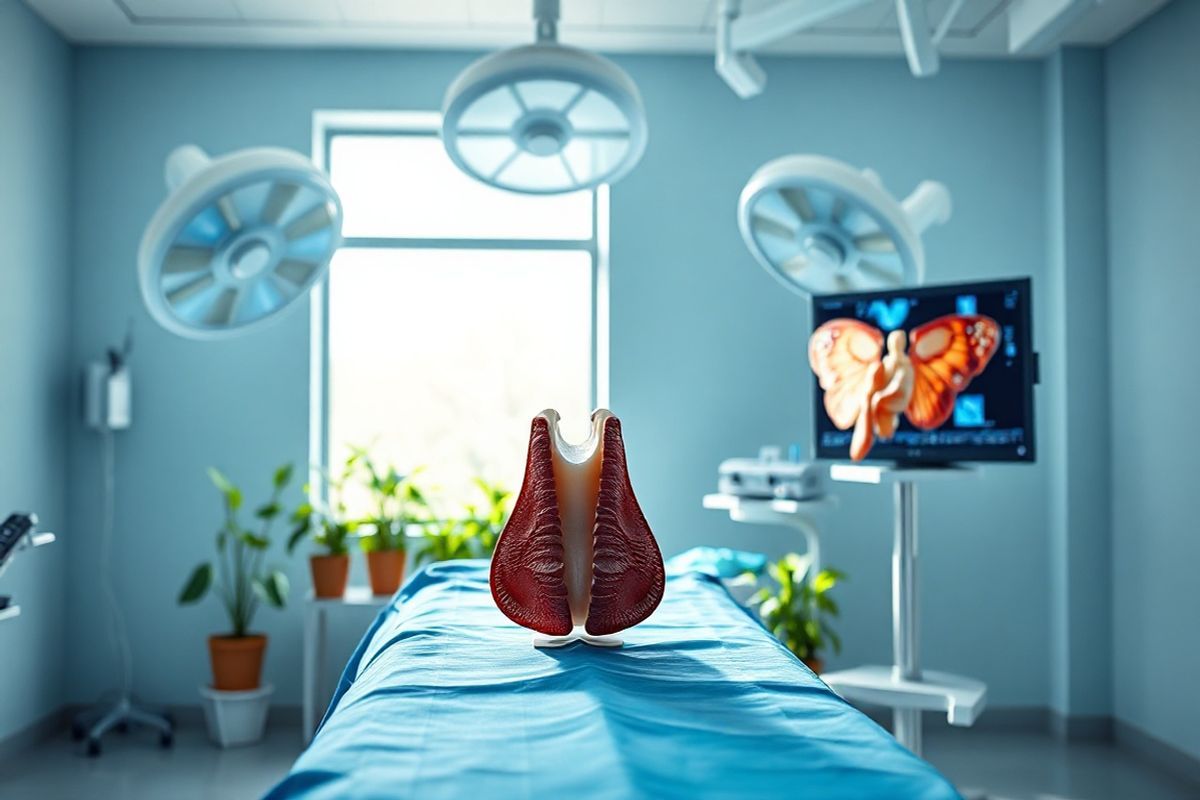Table of Contents
Understanding Thyroid Lobectomy: What Patients Need to Know

A thyroid lobectomy involves the surgical removal of one lobe of the thyroid gland, which is a butterfly-shaped organ located at the base of the neck. The thyroid plays a crucial role in producing hormones that regulate metabolism and other bodily functions. This surgery is often indicated for patients with thyroid nodules, benign growths, or early-stage thyroid cancer.
During a thyroid lobectomy, surgeons make a small incision in the neck, typically about 1-2 inches long, to remove the affected lobe while preserving the other lobe, parathyroid glands, and nearby structures, including the recurrent laryngeal nerve, which controls voice function. This meticulous approach minimizes risks and enhances cosmetic outcomes (Thyroid Surgery - Thyroidectomy Surgery, 2023).
The surgery usually lasts about 1.5 hours under general anesthesia, and patients typically stay in the hospital for one to two days. A key advantage of a lobectomy over a total thyroidectomy is the preservation of some thyroid function, which may prevent the need for lifelong hormone replacement in many patients (Thyroid Lobectomy: Removal of Half of Thyroid, 2023).
| Procedure | Duration | Hospital Stay | Hormone Replacement |
|---|---|---|---|
| Thyroid Lobectomy | 1.5 hours | 1-2 days | May not be required |
| Total Thyroidectomy | 2 hours | 1-2 days | Lifelong replacement |
The Role of Thyroid Hormone Replacement After Lobectomy
Post-surgery, the need for thyroid hormone replacement therapy (THRT) varies significantly based on the amount of thyroid tissue remaining. After a total thyroidectomy, patients will require lifelong THRT to replace the hormones that their body can no longer produce. Typically, this therapy involves synthetic levothyroxine, which mimics the hormone thyroxine (T4) produced by the thyroid.
Conversely, after a lobectomy, approximately 60-70% of patients may not need thyroid hormone replacement due to the remaining lobe’s ability to produce adequate hormone levels (Cleveland Clinic, 2023). It is important for patients to have regular follow-ups with their healthcare provider to monitor thyroid hormone levels through blood tests, specifically measuring Thyroid-Stimulating Hormone (TSH) levels, which indicate how well the remaining thyroid tissue is functioning.
Factors Influencing the Need for Hormone Replacement
- Extent of Lobectomy: The more thyroid tissue removed, the higher the likelihood of requiring hormone replacement.
- Individual Variability: Each patient’s ability to produce thyroid hormones varies; some may need THRT sooner than others.
- Underlying Conditions: Patients with pre-existing thyroid issues, such as Hashimoto’s thyroiditis, may require THRT regardless of the extent of surgery.
Potential Side Effects of Thyroid Lobectomy: What to Expect
While thyroid lobectomy is generally considered a safe procedure, it does carry potential risks and side effects. Understanding these can help patients prepare for their recovery.
Common Side Effects
- Hoarseness: Patients may experience a temporary change in their voice due to irritations or injuries to the laryngeal nerve. The risk of temporary hoarseness after lobectomy is about 2.5%, while the risk of permanent changes is less than 1% (Columbia Surgery, 2023).
- Hypoparathyroidism: There is a risk of damaging the parathyroid glands, which regulate calcium levels in the body. This can lead to low calcium levels, causing symptoms like numbness and muscle cramps. The risk of this complication is less than 1% (Thyroidectomy, 2023).
- Infection or Hematoma: Like any surgery, there is a risk of infection or bleeding in the surgical area, with rates being below 1% (Mayo Clinic, 2023).
Long-term Effects
In the long run, some patients may develop hypothyroidism if the remaining thyroid lobe does not produce sufficient hormones. Regular monitoring of thyroid function is crucial to manage this risk effectively.
Recovery Journey: Essential Tips for Post-Thyroid Lobectomy Care

Recovery after thyroid lobectomy involves managing discomfort and monitoring for complications. Here are essential tips for patients:
Immediate Post-operative Care
- Pain Management: Patients may experience pain at the surgical site, which can be managed with prescribed pain medications. Generally, over-the-counter pain relievers are sufficient for most patients (Thyroid Surgery Process, 2023).
- Incision Care: Keep the surgical site clean and dry. Avoid soaking in water or scrubbing the area for at least one week post-surgery.
- Monitoring Symptoms: Watch for signs of complications such as excessive bleeding, swelling, or infection at the incision site. If any concerning symptoms arise, contact the healthcare provider immediately.
Long-term Recovery Tips
- Follow-up Appointments: Schedule regular follow-up visits to monitor thyroid hormone levels and adjust THRT if necessary.
- Diet: Most patients can resume their normal diet within a day or two after surgery. However, starting with softer foods can be helpful if swallowing is uncomfortable.
- Activity Restrictions: Avoid heavy lifting and strenuous activities for about three weeks post-surgery to ensure proper healing.
Navigating Long-term Health: Monitoring Thyroid Hormone Levels After Surgery
Post-operative monitoring is critical for maintaining optimal health after a thyroid lobectomy. Patients should be aware of the necessary tests and follow-ups to ensure their thyroid hormone levels remain within the desired range.
Recommended Monitoring Schedule
- Initial Blood Tests: After surgery, patients typically undergo blood tests every 6-8 weeks to monitor TSH and thyroid hormone levels until stable levels are achieved.
- Annual Check-ups: Once thyroid levels stabilize, annual follow-ups with blood tests are recommended to ensure ongoing thyroid function.
Recognizing Symptoms of Imbalance
Patients should be vigilant about recognizing signs of thyroid hormone imbalance, which can include:
- Fatigue
- Weight changes
- Mood swings
- Sensitivity to temperature changes
Immediate communication with a healthcare provider regarding these symptoms is essential for timely adjustments to hormone replacement therapy.
FAQ
1. What is the recovery time after a thyroid lobectomy?
Most patients can return to normal activities within a week, but full recovery may take up to a month. Follow-up care is essential for monitoring healing.
2. Will I need to take thyroid hormone replacement after a lobectomy?
Approximately 60-70% of patients may not require hormone replacement after a lobectomy, but regular monitoring is crucial.
3. What are the risks associated with thyroid lobectomy?
Risks include temporary hoarseness, low calcium levels, and potential infection. Most complications are rare.
4. How can I manage pain after surgery?
Pain can be managed with prescribed medications and over-the-counter pain relievers. Consult your doctor for recommendations.
5. What lifestyle changes should I consider post-surgery?
Maintaining a balanced diet and avoiding strenuous activities for a few weeks can aid in recovery. Regular follow-up appointments are also vital.
References
- Thyroid Surgery - Thyroidectomy Surgery. https://www.uclahealth.org/medical-services/surgery/endocrine-surgery/conditions-treated/thyroid/thyroid-surgery
- Thyroidectomy. https://www.mayoclinic.org/tests-procedures/thyroidectomy/about/pac-20385195
- Thyroid Surgery Process. https://www.pennmedicine.org/for-patients-and-visitors/find-a-program-or-service/surgery/thyroid-surgery/what-to-expect-at-penn
- Cleveland Clinic. https://my.clevelandclinic.org/health/treatments/7016-thyroidectomy
- Columbia Surgery. https://columbiasurgery.org/conditions-and-treatments/thyroid-surgery










